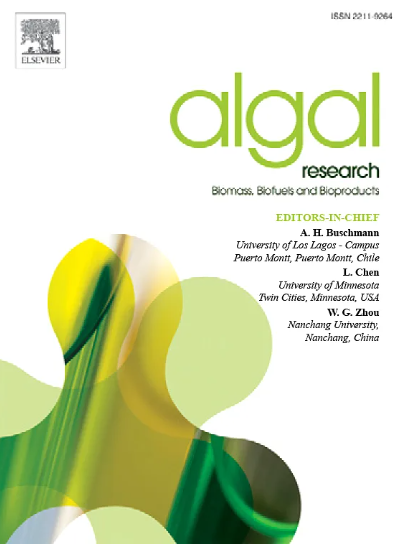微藻的可逆电渗透:脉冲电场诱导的传质和膜重封动力学追踪
IF 4.5
2区 生物学
Q1 BIOTECHNOLOGY & APPLIED MICROBIOLOGY
Algal Research-Biomass Biofuels and Bioproducts
Pub Date : 2025-06-03
DOI:10.1016/j.algal.2025.104125
引用次数: 0
摘要
脉冲电场(PEF)处理是一种通过诱导细胞渗透来增强传质的新兴技术,在微藻生物处理中具有很大的潜力。虽然提取的不可逆渗透作用已经被广泛研究,但大多数微藻物种的可逆渗透作用仍未被广泛探索,从而限制了其在需要活细胞的过程中的应用,如循环提取、基因传递和细胞强化。本文研究了电场强度和脉冲分割配置(单长脉冲和多短脉冲)对原草球藻可逆电渗透的影响。细胞膜不透性染色剂Sytox Green™的摄取用于评估细胞透性,而蛋白质提取作为传质指标。结果表明,分离脉冲配置(2 × 50 μs或5 × 20 μs脉冲,15 kV cm−1)与单一长脉冲相比,相对荧光强度增加了5倍,而能量输入仅增加12%。分裂脉冲方法使细胞保持渗透性超过10分钟,与20 kV cm - 1的单脉冲相比,可以在比单脉冲低41%的能量下多提取38%的蛋白质,但这种更高程度的渗透性损害了细胞活力,使约70%的细胞失活,并在前48小时内延迟再生,从而阻碍了活细胞应用的适用性。我们首次研究了原蠓对高电场的抗性,例如,15 kV cm - 1的单脉冲可使细胞通透至少5分钟,同时保持良好的再密封和存活率,与未处理的对照相当。这些发现为最大化微藻的可逆渗透、传质和细胞存活,同时最大限度地减少PEF处理过程中的能量消耗提供了有价值的见解。本文章由计算机程序翻译,如有差异,请以英文原文为准。

Reversible electropermeabilization of Auxenochlorella protothecoides microalgae: tracking mass transfer and membrane resealing dynamics induced by pulsed electric fields
Pulsed Electric Field (PEF) treatment is an emerging technology that enhances mass transfer by inducing cell permeabilization, offering great potential in microalgae bioprocessing. While irreversible permeabilization for extraction has been extensively studied, reversible permeabilization remains largely unexplored for most microalgae species, thus limiting its application in processes requiring viable cells, such as cyclic extraction, gene delivery, and cell fortification. This study investigated how electric field strength and split pulse configuration, either a single long pulse or multiple shorter pulses, affect the reversible electropermeabilization of Auxenochlorella protothecoides. The uptake of the cell membrane-impermeable stain Sytox Green™ was used to assess cell permeabilization, while protein extraction served as a mass transfer indicator. Results showed that a split pulse configuration (2 × 50 μs or 5 × 20 μs pulses at 15 kV cm−1) increased the relative fluorescence intensity fivefold compared with a single long pulse, with only a 12 % increase in energy input. The split pulse approach kept the cells permeable for over 10 min, enabling 38 % more protein extraction with 41 % less energy than a single pulse at 20 kV cm−1, but this higher degree of permeabilization compromised cell viability, inactivating around 70 % of the cells and delaying regrowth during the first 48 h, thereby hindering suitability for live-cell applications. For the first time, the resistance of A. protothecoides to high electric fields has been investigated, e.g., with a single pulse of 15 kV cm−1 permeabilizing the cells for at least 5 min while maintaining good resealing and survival rates comparable to the untreated control. These findings offer valuable insights into maximizing reversible permeabilization, mass transfer, and cell survival in microalgae while minimizing energy consumption in PEF processing.
求助全文
通过发布文献求助,成功后即可免费获取论文全文。
去求助
来源期刊

Algal Research-Biomass Biofuels and Bioproducts
BIOTECHNOLOGY & APPLIED MICROBIOLOGY-
CiteScore
9.40
自引率
7.80%
发文量
332
期刊介绍:
Algal Research is an international phycology journal covering all areas of emerging technologies in algae biology, biomass production, cultivation, harvesting, extraction, bioproducts, biorefinery, engineering, and econometrics. Algae is defined to include cyanobacteria, microalgae, and protists and symbionts of interest in biotechnology. The journal publishes original research and reviews for the following scope: algal biology, including but not exclusive to: phylogeny, biodiversity, molecular traits, metabolic regulation, and genetic engineering, algal cultivation, e.g. phototrophic systems, heterotrophic systems, and mixotrophic systems, algal harvesting and extraction systems, biotechnology to convert algal biomass and components into biofuels and bioproducts, e.g., nutraceuticals, pharmaceuticals, animal feed, plastics, etc. algal products and their economic assessment
 求助内容:
求助内容: 应助结果提醒方式:
应助结果提醒方式:


